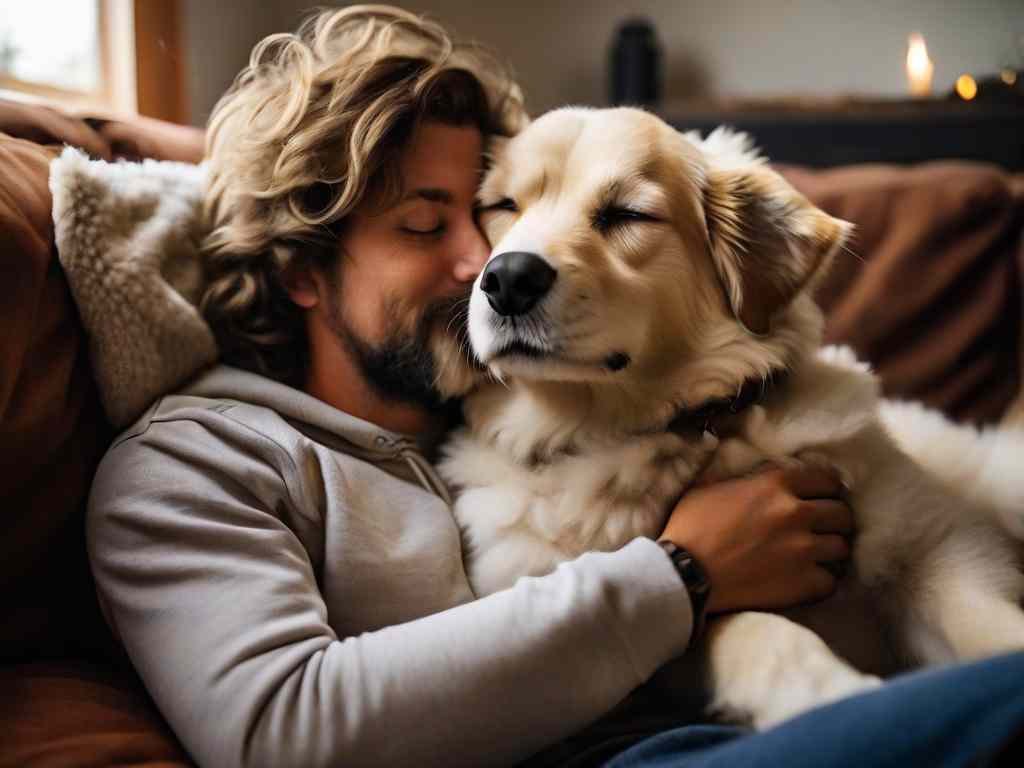If you’ve ever been sitting on your sofa and suddenly felt the comforting weight of your dog leaning against you, you might have wondered why they do it. Dogs, being the social animals they are, love to stay close to their humans. When a dog leans on you, it is usually a sign of affection and trust. They might be seeking comfort, reassurance, or simply enjoying the physical closeness.
Dogs are pack animals by nature, and their leaning is a way of expressing closeness with their human pack. Bigger dogs, who can’t fit on laps as easily as smaller ones, often use leaning as a way to get as close to you as possible. This behaviour can strengthen the bond between you and your dog, building a deeper sense of security on both sides.
Some dogs lean when they feel anxious or vulnerable. Storms, loud noises, or even new experiences might prompt them to seek the safety of your side. By leaning into you, dogs find reassurance and comfort, knowing they’re safe with their trusted human. Understanding this behaviour can help you respond to your dog’s needs, enriching your relationship even further.
Understanding Canine Behaviour
Dogs often lean on their owners to show affection or to find comfort and security. These actions can strengthen the bond between you and your furry friend and offer insights into their emotional state. Here’s what you need to consider.
Signs of Affection
When your dog leans on you, it can be a sign of love. Dogs use their bodies to communicate, and leaning is one way to show they care.
Much like how humans enjoy hugs, dogs use leaning as a way to feel close. This behaviour can develop from when they were puppies, cuddling with their littermates.
Leaning is a sign that your dog trusts you and feels safe by your side. Recognise their affection and respond with gentle pets or kind words, so they know their feelings are returned. This can make your relationship even stronger.
Seeking Comfort or Security
Sometimes your dog leans on you because they are feeling anxious or scared. Leaning can make them feel more secure and protected.
You might notice this behaviour during fireworks, thunderstorms, or even in new environments. It’s a way for them to seek reassurance from you.
Be sure to comfort them when they show signs of distress. Offering a calm presence and speaking softly can help soothe your dog. Understanding and addressing their need for comfort shows them that you are a reliable source of safety, which can ease their stress and build trust.
The Bond Between Dogs and Their Owners
The connection between you and your dog is built on several key elements that create a strong and lasting relationship. These include trust, dependency, communication, and interaction. Each plays a vital role in how you and your furry friend relate to each other.
Trust and Dependency
When your dog leans on you, it shows trust and dependency. Trust is a crucial part of your bond. Dogs see you as a source of safety and comfort. They rely on you for food, care, and affection, creating a deep sense of dependency.
This trust takes time to build. With consistent care and positive experiences, your dog learns you are dependable. They know you will provide for their needs and protect them from harm.
Dogs may lean on you to feel more secure. This physical closeness is comforting to them and reassures them of your presence. Leaning can be a sign that your dog feels comfortable around you and trusts you entirely.
Communication and Interaction
Communication between you and your dog is not just about words — it’s about the interactions and signals you both share. Dogs are keen on reading your body language, tone of voice, and even your facial expressions.
Through these cues, dogs understand your emotions and respond with behaviours like leaning. This leaning acts as a form of interaction. It’s your dog’s way of connecting and communicating their needs or affection to you.
Regular interaction plays a large role in strengthening your bond. Activities such as playing, walking, and even simple cuddling are vital. These shared moments deepen your connection and help your dog understand you better, enhancing your relationship.
Health and Well-being Considerations
Dogs often lean on their owners due to emotional and physical reasons. Anxiety and behavioural issues might prompt this leaning behaviour, with dogs seeking comfort and reassurance. Physical health factors, like pain or discomfort, can also lead dogs to lean as a form of support or communication.
Anxiety and Behavioural Issues
Dogs can express their anxiety through physical contact. When a dog leans on you, it might be seeking comfort or reassurance. Leaning can be a way to feel safe during stressful situations, like loud noises or new environments.
Changes in routine or separation anxiety may also be the cause of leaning. It’s important to observe other signs like trembling or lowered posture to gauge if your dog is feeling anxious. Offering a calming presence and using positive reinforcement can help. Create a safe space for your dog where it can retreat and feel secure, like a comfortable corner with toys and blankets. Regular routine and exercise can also help alleviate anxiety.
Physical Health Factors
Physical discomfort might prompt your dog to lean on you. Conditions like arthritis or muscle pain can make a dog seek support by leaning. Pay attention to any changes in your dog’s movement or behaviour when they lean on you.
If your dog leans more frequently, it might be a sign to visit the vet. Regular check-ups and monitoring can ensure your dog’s physical health is managed well. Providing a comfortable resting area with soft bedding can help ease any discomfort. Being observant of your dog’s behaviour and responsive to their needs can aid in maintaining their well-being.

